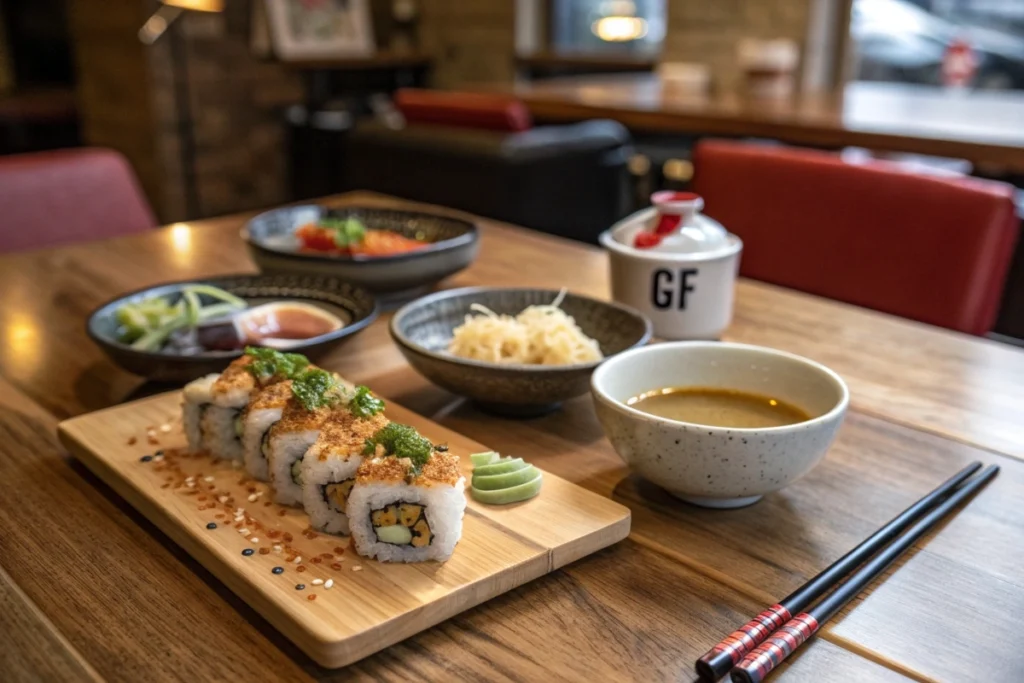Gluten intolerance or celiac disease doesn’t have to stop you from enjoying the flavors of Japan. The world of gluten free japanese food is vast, offering everything from traditional rice-based meals to creative takes on noodles and sauces. Although soy sauce often contains wheat, and popular dishes like ramen or takoyaki typically use wheat flour, plenty of alternatives exist for safe and delicious dining. Whether you’re cooking at home or eating out in tokyo gluten free restaurants, a bit of know-how transforms what might seem like a restrictive diet into a culinary journey.
In this comprehensive guide, we’ll explore key tips for finding and preparing gluten free japanese food, from reading ingredient labels to picking the right condiments. We’ll also discuss how to spot “hidden wheat” in everything from miso soup to breaded katsu. For those planning a trip to Japan, we’ll outline the best strategies for dining at local establishments that respect gluten-free requirements. Meanwhile, if you’re cooking at home, you’ll discover safe substitutions for wheat-based items, plus recommended brands. Along the way, we’ll link to helpful resources like our japanese-vegan-recipes guide, which can double as a handy reference for gluten-free eaters who avoid certain proteins.
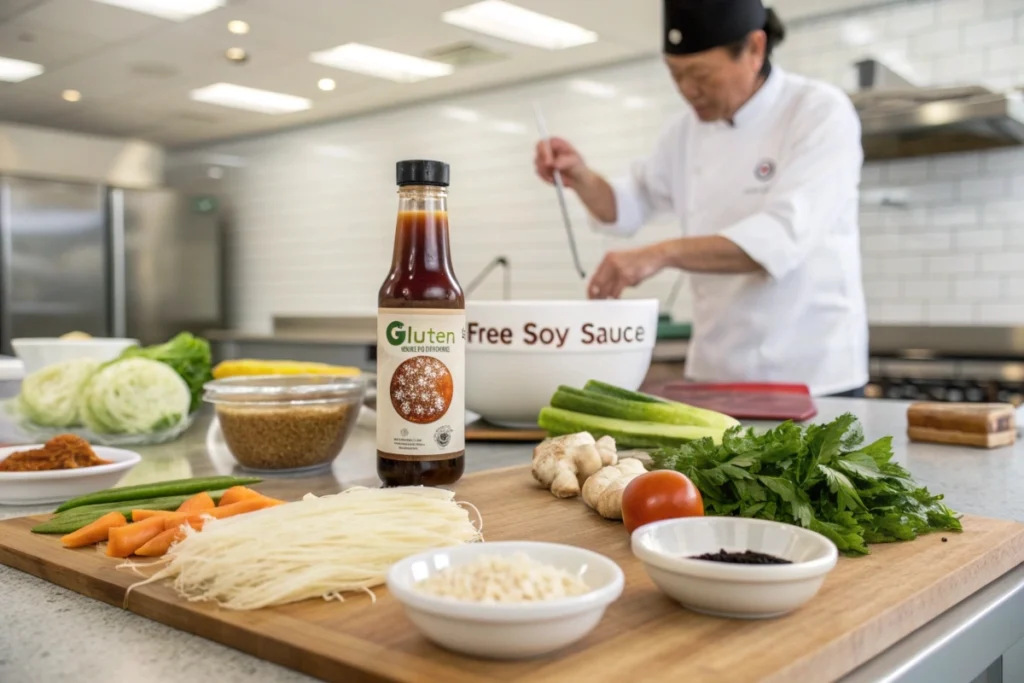
Main Sections
1. Understanding Gluten in Japanese Cuisine
Gluten commonly appears in wheat-based items like bread, pasta, and pastries. In Japanese cooking, it often sneaks in through soy sauce, flour-based coatings, and certain seasonings. While rice is a staple, wheat remains a hidden culprit in many items. Recognizing potential pitfalls becomes crucial for those seeking gluten free japanese food.
Key Gluten Sources in Japanese Meals
- Soy Sauce: Traditional soy sauce typically includes wheat. However, tamari or gluten-free shoyu exist as safe alternatives.
- Noodles: Classic ramen uses wheat flour. But soba might also contain a wheat blend unless labeled 100% buckwheat (juwari soba).
- Tempura Batter: Standard batter includes wheat flour. Look for specially marketed gluten-free tempura mixes or use cornstarch/tapioca blends.
- Sauces & Dressings: Watch out for hidden wheat-based thickeners or barley miso.
For instance, if you’re making tonkatsu at home, you might rely on panko breadcrumbs, which can contain wheat. Seek gluten-free panko from specialty brands or crush rice crackers to mimic the crunchy texture. Similarly, hibachi grills often drizzle soy sauce on items—so confirm if they stock wheat-free versions. For more on how to adapt your cooking, see recipe-for-japanese-tofu to discover ideas for sauce replacements and tofu cooking tips.
Identifying Safe Options
- Rice-Based Dishes: Sushi, onigiri, and many donburi bowls typically use plain rice. Just ensure the marinade or sauce doesn’t hide wheat.
- Miso Soup: Some miso uses barley or wheat. Opt for rice-based miso (kome miso).
- Tamari Soy Sauce: Tamari is typically brewed without wheat, though always check the label.
- Gluten-Free Flour: For homemade noodles or tempura, look for mixes labeled “GF” or use safe flours like potato, cornstarch, or buckwheat (100%).
Checking Labels and Cross-Contamination
In Japan, komugi means wheat. Also, “小麦” on labels indicates wheat presence. Restaurants might not fully grasp celiac-level cross-contamination issues. Using translation cards or polite requests can help. For travelers, gluten free in japan resources and support groups exist online, directing you to tested spots or specialized tokyo gluten free restaurants.
By understanding these fundamentals, you’ll better navigate menus, grocery aisles, and cooking tasks. Combine that knowledge with flexible substitutes—like tamari for soy sauce or pure buckwheat soba for wheat noodles—to fully enjoy gluten-free Japanese meals. If you love noodles, check out our noodles-japanese-pan-noodles-recipe and adapt it with GF soy sauce. That synergy of tradition and safe modifications ensures you relish every bite, minus the gluten.
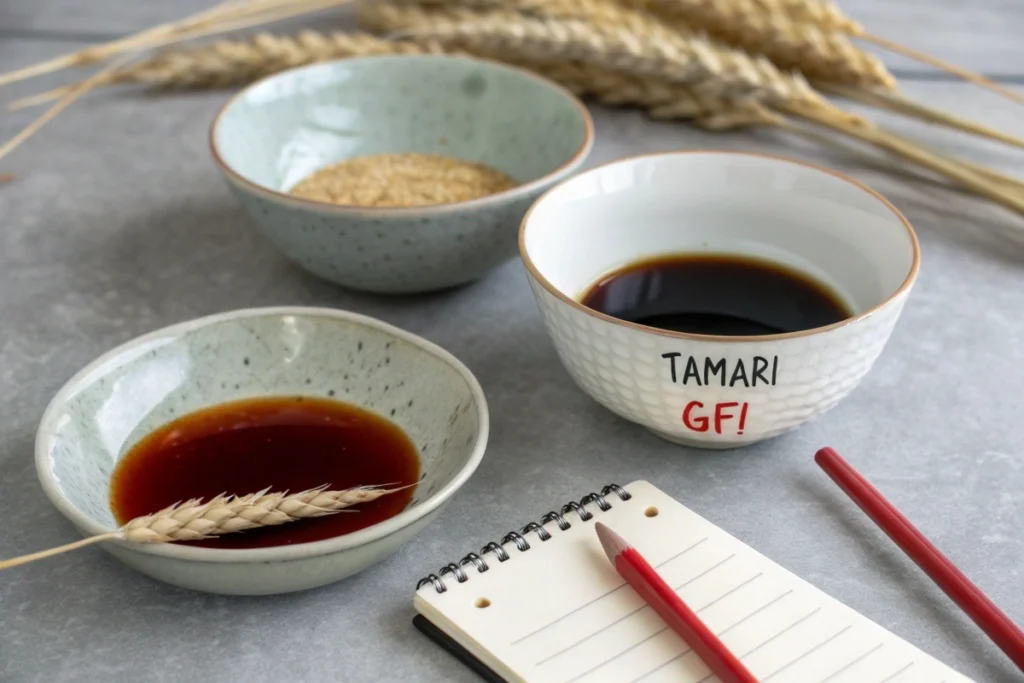
2. Navigating Gluten-Free Tokyo and Beyond
Traveling to Japan as a gluten-free eater needn’t be daunting. Cities like Tokyo, Kyoto, and Osaka boast growing awareness of celiac requirements. Gluten free tokyo is no longer a far-fetched concept—restaurants, bakeries, and even convenience stores occasionally stock safe products. However, preparedness remains key.
Finding Gluten-Free Restaurants
- Dedicated GF Spots: Some cafés or small eateries explicitly label themselves gluten-free, especially near international hubs or major train stations.
- Menu Markings: Large chains might list allergen info. Watch for “小麦 (wheat)” or “グルテンフリー” (gluten-free).
- Coeliac Cards: Travelers often carry cards in Japanese stating their condition. Handing it to servers prevents misunderstandings about soy sauce or flour usage.
Tricks for Street Food
In Tokyo’s bustling food stalls, items like takoyaki or okonomiyaki typically use wheat batter. Alternative stalls sometimes offer GF versions, but they’re rare. If you see gluten free in japan signage at a pop-up, confirm cross-contamination protocols (shared grills or mixing tools can be problematic).
Hotel and Airbnb Solutions
If you have kitchen access, consider cooking your own meals. Tokyo has specialty stores offering GF soy sauce, miso, and safe noodles. For instance, Aeon supermarkets or international sections of bigger department stores might carry these items. Pair them with local produce to craft a quick meal referencing japanese-new-year-recipes for holiday flavors, adapted to gluten-free needs.
Regional Variations
- Kyoto: Known for tofu and vegetable dishes, which can be naturally GF if sauces are wheat-free.
- Osaka: Street foods like takoyaki are typically wheat-based, but certain experimental vendors might use rice flour. Seek them out or ask local GF communities.
- Hokkaido: Fresh seafood and simpler preparations reduce wheat risk. Yet, confirm marinade contents.
Research and Tech Tools
Use apps or sites that compile user reviews about gluten-free dining—like “Find Me GF” or local celiac groups in Japan. SERP (Search Engine Results Page) analysis also helps. Searching “tokyo gluten free restaurants” yields top hits—some are well-reviewed by travelers. Always cross-check recency of info since menus change.
Communicating in Japanese
Learning a few phrases clarifies concerns:
- “Komugi nashi de onegai shimasu” (No wheat, please).
- “Gluten free desu” (I’m gluten-free).
- “Komugi ga haitte imasu ka?” (Does this contain wheat?).
By combining these strategies, you’ll enjoy gluten free japanese food across Tokyo and beyond. Whether exploring ramen shops with GF noodles or indulging in mochi desserts, the city’s diverse offerings ensure you don’t miss out. For cooking enthusiasts, a japanese-chicken-fried-rice-recipe- can easily adapt to GF sauce, letting you savor comfort food in your lodging’s kitchenette.
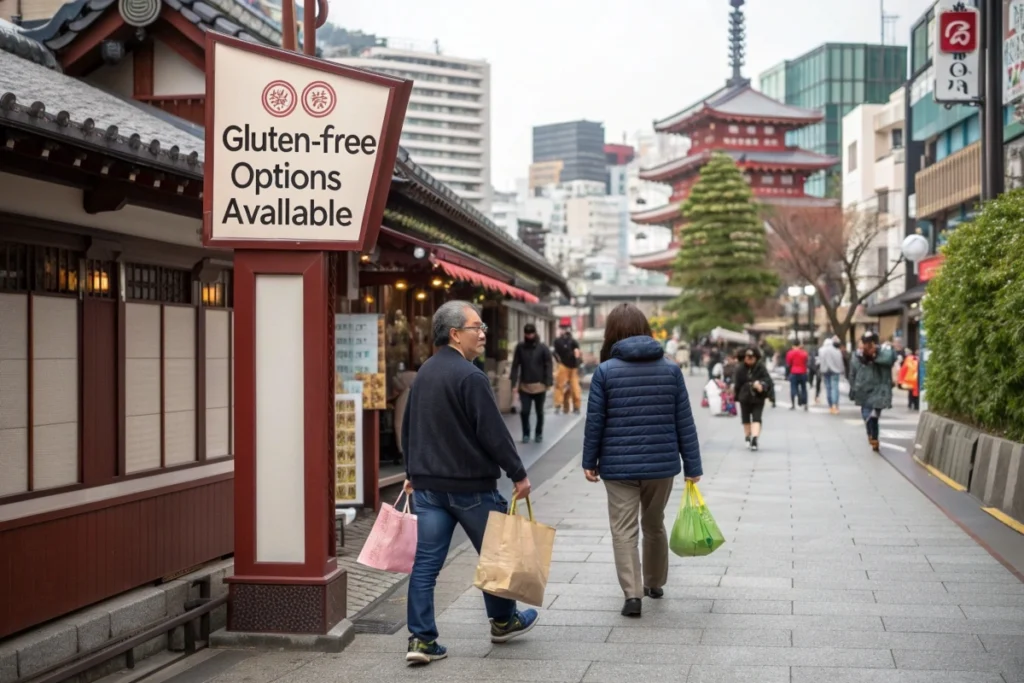
3. History and Background of Gluten-Free Japanese Food
The notion of gluten free japanese food might seem modern, but its roots in Japan’s culinary past run deeper than one might think. Traditionally, Japanese cuisine relies heavily on rice, fish, soy-based ingredients, and vegetables—wheat wasn’t always integral. Over centuries, however, Western influences introduced bread, pasta, and wheat-based sauces, gradually embedding gluten into everyday cooking.
Ancient Rice Culture
Japan’s agrarian society thrived on rice for thousands of years. Early diets included fish, seaweed, and fermented products like miso or soy sauce (often with minimal or no wheat). Many classic dishes—like grilled fish with salt or simple rice bowls—were naturally gluten-free.
Introduction of Wheat
During the Nara and Heian periods, some forms of wheat-based noodles found their way into the aristocratic class. However, large-scale wheat consumption soared once Western bread, pastries, and flour-based items gained popularity post-Meiji Restoration. As a result, everyday sauces like soy sauce or ponzu often incorporated wheat, standardizing its presence in households.
Miso and Soy Sauce Evolution
Originally, some soy sauces (tamari style) contained little to no wheat. Over time, cost-effective production favored blends that used wheat to speed fermentation. Similarly, miso had variants: mugi miso (barley-based), kome miso (rice-based), or mame miso (pure soy). Rice miso typically remains gluten-free, aligning with older traditions.
Modern Gluten Awareness
In the 20th century, celiac disease and gluten intolerance recognition rose internationally. Japan initially lagged in awareness since wheat consumption was comparatively lower, and many traditional meals were rice-centric. But as bread, noodles, and modern pastries soared in popularity, more Japanese individuals started questioning if gluten intolerance existed domestically.
- Influence of Western Medicine: Diagnoses of celiac became more common, even if less prevalent in Japan than Western countries.
- Rise of Alternative Flours: Markets began seeing rice flour, buckwheat, and other gluten-free flours, paving the way for GF bread, noodles, and desserts.
- Restaurant Adaptations: As foreign tourists with celiac visited Japan, restaurants around Tokyo or Kyoto introduced tamari-based sauces, GF ramen, or disclaimers on menus.
Contemporary Scene
Today, is gluten intolerance common in Japan? Not as widespread as in the West, but rising. Younger chefs experiment with GF recipes, and store shelves occasionally label items as “グルテンフリー” (Gluten-Free). This phenomenon extends beyond local interest—tourists seeking gluten free in japan experiences push demand for wheat-free options in major cities. For instance, traditional-japanese-desserts-recipe can adapt to GF flours, reflecting a renewed embrace of older, rice-centric customs.
Ultimately, the history of gluten free japanese food merges Japan’s ancient reliance on rice with modern health consciousness. Though wheat infiltration shaped many current dishes, a return to ancestral methods or thoughtful ingredient swaps now fosters inclusive, celiac-friendly feasting.
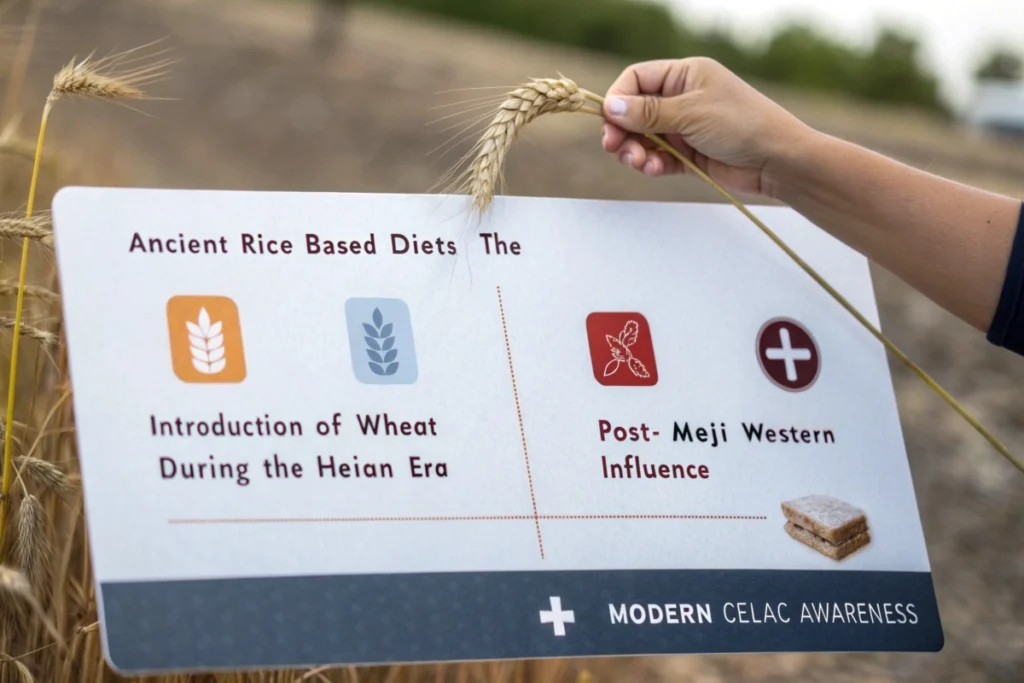
4. Practical Examples and Use Cases
Case 1: Home Cook Craving Tempura
Beth, newly diagnosed with celiac, adores Japanese tempura. She visits an Asian store to find gluten-free tempura flour made from rice and tapioca. Following steak-japanese-recipe marinade guidance but swapping out soy sauce for tamari, she crafts a delicious GF meal. Her family hardly notices the difference. This scenario shows how easy ingredient tweaks let you replicate beloved dishes.
Case 2: Traveling to Tokyo
Daniel plans a week in Tokyo. Armed with translations (“wheat-free, please”) and a list of gluten free tokyo restaurants, he navigates ramen shops that offer GF noodles. He also hits a famed sushi spot which uses tamari upon request. Along the way, he finds a GF bakery in Shinjuku selling bread and pastries he never thought possible in Japan—proving GF travel is far from limiting.
Case 3: Corporate Event at a Japanese Hibachi Grill
A local Pittsburgh company organizes a team dinner at a hibachi grill. One colleague has celiac. After calling ahead, the restaurant stocks GF soy sauce. During the show, the chef carefully uses separate utensils to avoid cross-contamination. Everyone enjoys the theatrical grilling experience, highlighting that is hibachi gluten free can be answered “yes” if staff remain mindful.
Case 4: Restaurant Owner Expanding Menu
A small ramen joint wants to include GF ramen. They source GF noodles from a specialized supplier and adopt tamari-based soup. By listing “100% gluten-free ramen” on their sign, they attract new customers. Some are celiac, others prefer a lighter broth. Their sales jump, confirming demand for gluten free japanese food in local communities.
Conclusion of Examples
These vignettes illustrate how gluten free japanese food isn’t a niche fad—it’s integrable into daily life, travel, social gatherings, and even business expansions. For further culinary inspiration, check out japanese-sweets-recipes for dessert ideas. Many mochi-based treats are inherently GF, offering sweet relief for celiac dessert lovers.
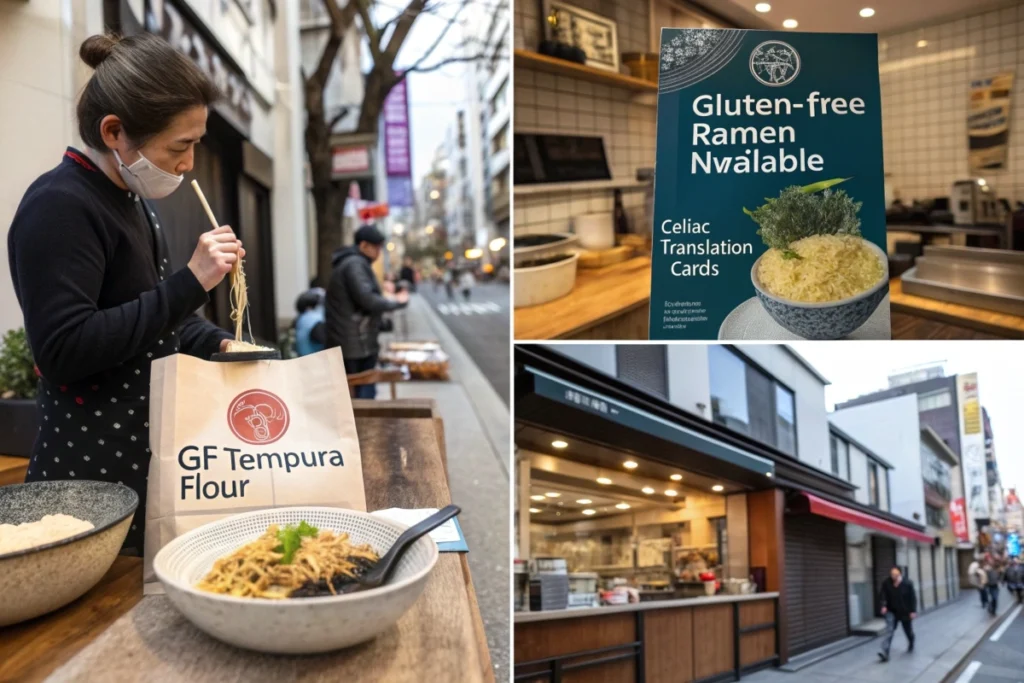
FAQs
1. What are gluten-free Japanese food options?
Staple items like rice, fresh vegetables, sashimi, and natto are naturally GF. Use tamari instead of regular soy sauce, check miso type, and choose 100% buckwheat soba. Many soups (like miso soup) are safe if the miso contains no barley or wheat.
2. Is gluten intolerance common in Japan?
Gluten intolerance or celiac disease remains less diagnosed in Japan than in Western countries, but awareness is growing. Large cities see rising demand for GF products, and more restaurants label allergen info in multiple languages. For travelers, gluten free in japan resources help navigate daily eating.
3. What is gluten-free in Japanese?
You can say “グルテンフリー (guruten furii)” or “小麦なし (komugi nashi)” to indicate wheat-free. Also, “グルテン不耐症 (guruten futaishō)” references gluten intolerance. Cards or phone translations help clarify cross-contamination concerns in restaurants.
4. Is there gluten in Japanese rice?
No, plain rice lacks gluten. However, watch for sushi rice seasoned with vinegar containing wheat or barley-based components. Confirm vinegar brand or use 100% GF rice vinegar. Additionally, rice crackers might contain soy sauce with wheat unless labeled GF.
5. What about hidden wheat in sauces or marinade?
Many sauces (teriyaki, oyster sauce) can contain wheat. Opt for brands labeled GF or rely on tamari-based soy sauce. Always scan ingredient lists for “wheat,” “barley,” or “malt.” For more sauce guidance, see japanese-barbecue-sauce-recipes and adapt them with GF replacements.
6. Are soba noodles always gluten-free?
Not always. Traditional soba might contain wheat flour unless labeled juwari soba (100% buckwheat). Check packaging or restaurant menus. Alternatively, look for GF noodle substitutes like rice noodles or sweet potato noodles for peace of mind.
7. How can I be certain about cross-contamination?
In Japan, restaurants may share grills, fryers, or prep surfaces. Politely asking about separate cooking utensils or dedicated equipment helps minimize risk. Communicating your needs upfront is vital, especially if you have celiac.
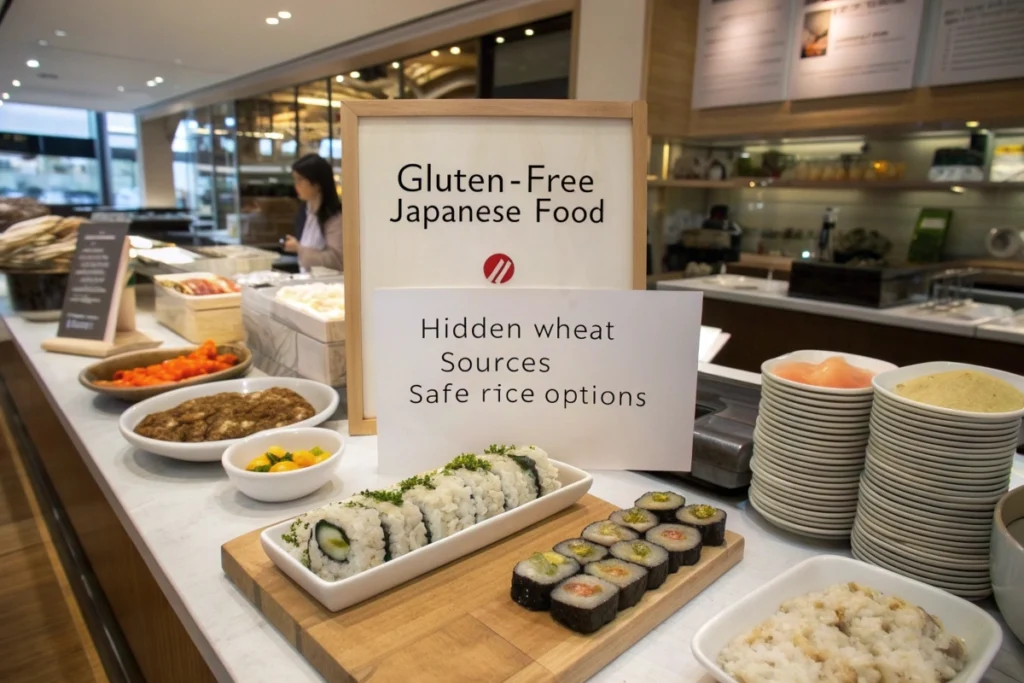
Conclusion
Pursuing a gluten free japanese food lifestyle can feel intimidating at first, but with the right knowledge, it opens a world of flavors. From tamari-based sauces to buckwheat noodles and mochi desserts, Japanese cuisine offers myriad naturally GF dishes. Adapting classic recipes is simpler than you might think—just confirm condiments are wheat-free, choose alternative flours, and stay vigilant about cross-contamination in shared kitchens or restaurants.
Whether you plan to visit Tokyo or replicate hibachi dinners at home, implementing a few strategies—like learning basic Japanese phrases for gluten-free and scouting celiac-friendly spots—ensures a seamless experience. If you’re craving sweet treats, apple-pastry-recipes-japanese can often be converted to GF with a suitable flour swap. The same principle applies to countless Japanese recipes: mindful ingredient checks and simple replacements.
As celiac awareness grows in Japan and abroad, more chefs, grocery stores, and everyday cooks embrace gluten-free adaptations. This inclusive attitude paves the way for a gastronomic adventure that respects your dietary needs without compromising taste. So explore with confidence, experiment with safe noodles and sauces, and celebrate the rich tapestry of Japanese flavors—gluten-free style!
